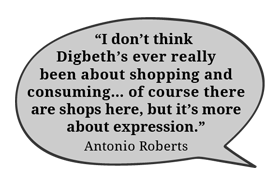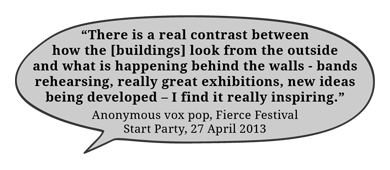Digbeth has a close-knit community of artists and is well-known for both its diverse range of creative talent and its fertile landscape for developing new ideas within the visual arts. It houses independent artists studios, galleries such as Eastside Projects and Grand Union, multi-let creative spaces such as Minerva Works and The Custard Factory, and groups of artist-led studios such as Grand Union studios and The Lombard Method. There are also many other digital and design businesses, like K4 Architects, Maverick Television and Blink Animation.
 Artist Antonio Roberts describes Digbeth’s arts scene as a community of people doing different things and he enjoys this diversity. For Antonio, Digbeth is a place where people are willing to “take a chance on very experimental stuff” such as the ‘GLI.TC/H’ festival in 2011 that he helped to organise. ‘GLI.TC/H’ showcased art that explores the beauty of corrupted files and the possibilities in sound that are created by breaking electronics. Furthermore, Antonio emphasises the importance of new, ground-breaking exhibitions in offering a vibrant alternative. For him, such exhibitions contribute towards the artistic and intellectual ideas of Birmingham.
Artist Antonio Roberts describes Digbeth’s arts scene as a community of people doing different things and he enjoys this diversity. For Antonio, Digbeth is a place where people are willing to “take a chance on very experimental stuff” such as the ‘GLI.TC/H’ festival in 2011 that he helped to organise. ‘GLI.TC/H’ showcased art that explores the beauty of corrupted files and the possibilities in sound that are created by breaking electronics. Furthermore, Antonio emphasises the importance of new, ground-breaking exhibitions in offering a vibrant alternative. For him, such exhibitions contribute towards the artistic and intellectual ideas of Birmingham.
Sara Preisler, a jeweller based in The Custard Factory, says that Digbeth’s history and inspiring landscape is symbolised by the River Rea. She notes that “there is a real legacy here that speaks strongly of the historic past – not just of the industrial past but also of pre-history.” She thinks that whilst the past continues to leave its industrial mark, it also inspires creative thinking in its urban spaces and, looking to the future, will attract more diverse activities such as sport.
Digbeth’s art scene is unique and its reputation for culture and community spirit is as equally strong. Artist Antonio Roberts indicates that members of Digbeth’s artistic community are friendly and provide a supportive environment for each other. He praises arts organisations such as VIVID and Grand Union for being very open and experimental with new media arts; for him, there are very few spaces in the West Midlands that would support this kind of art.
 Defined by an industrial landscape, Digbeth’s strong identity and free spirit is described by Niall from arts collective, MSFAC, as a ‘pop-up’ culture of stores, ideas and events. Niall emphasises that within this shifting landscape lies a strong connection between the artist and Digbeth. MSFAC’s next step is to engage the local community whose stories and histories are under-represented and to work with new values outside the influence of elite art institutions.
Defined by an industrial landscape, Digbeth’s strong identity and free spirit is described by Niall from arts collective, MSFAC, as a ‘pop-up’ culture of stores, ideas and events. Niall emphasises that within this shifting landscape lies a strong connection between the artist and Digbeth. MSFAC’s next step is to engage the local community whose stories and histories are under-represented and to work with new values outside the influence of elite art institutions.
Stryx Arts Collective, a group of graduates who established their own artist-led studio, came to Digbeth for the positive and collaborative environment that it offered. This provided an ideal platform from which to develop their art practices as well as their business. One person we interviewed at Grand Union describes Digbeth as “layered, gritty, and full of potential”. This ’potential’ is what continues to attract many artists and events to Digbeth, such as the continued presence of Fierce Festival in Digbeth.
 John Mostyn reminisces on the wide variety of music styles that have entertained audiences in Digbeth since the 1970s, from reggae, opera, punk and metal to folk music. Talking to John, it becomes clear that promoters, studios and pubs such as The Mercat Cross, The Rainbow and The Spotted Dog, have helped to make up the cultural fabric of Digbeth’s unique music scene and inspired generations over the years. Some venues have helped set new trends, such as techno in the 1980s, and have been home to prominent bands like UB40, who played to support The Rainbow when it was threatened with closure in 2009.
John Mostyn reminisces on the wide variety of music styles that have entertained audiences in Digbeth since the 1970s, from reggae, opera, punk and metal to folk music. Talking to John, it becomes clear that promoters, studios and pubs such as The Mercat Cross, The Rainbow and The Spotted Dog, have helped to make up the cultural fabric of Digbeth’s unique music scene and inspired generations over the years. Some venues have helped set new trends, such as techno in the 1980s, and have been home to prominent bands like UB40, who played to support The Rainbow when it was threatened with closure in 2009.
Alexei Berrow from the band Johnny Foreigner talks positively about the diversity of Digbeth’s music scene and the sense of community that supports musicians in establishing their careers.
Tucked away amongst the concrete buildings and warehouses in Digbeth are studios, rehearsal spaces and venues. Alexei has used several rehearsal spaces in Digbeth. However, he compares Digbeth critically to Shoreditch in London, and is concerned that if developers move in, costs will increase, which, he says, will force musicians to leave. Ralph Morton, who has used several warehouse spaces for band practices, now uses Muther’s Recording Studio on Rea Street. He says that in contrast to the warehouses, Muther’s feels like a community because the social spaces there allow him to get to know the other bands. The studio has recently been refurbished which, he argues, suggests that the owners feel it is worth investing in for the future.